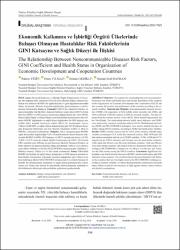| dc.contributor.author | Yiğit, Pakize | |
| dc.contributor.author | Yılmaz, Emre | |
| dc.contributor.author | Gedikli, Erman | |
| dc.contributor.author | Hayran, Osman Erol | |
| dc.date.accessioned | 2023-03-31T11:03:24Z | |
| dc.date.available | 2023-03-31T11:03:24Z | |
| dc.date.issued | 2021 | en_US |
| dc.identifier.citation | Yiğit, P., Yılmaz, E., Gedikli, E. ve Hayran, O. E. (2021). Ekonomik kalkınma ve işbirliği örgütü ülkelerinde bulaşıcı olmayan hastalıklar risk faktörlerinin GINI katsayısı ve sağlık düzeyi ile ilişkisi. Türkiye Klinikleri Sağlık Bilimleri Dergisi, 6(3), 598-608. https://dx.doi.org/10.5336/healthsci.2020-77423 | en_US |
| dc.identifier.issn | 2536-4391 | |
| dc.identifier.uri | https://dx.doi.org/10.5336/healthsci.2020-77423 | |
| dc.identifier.uri | https://hdl.handle.net/20.500.12511/10791 | |
| dc.description.abstract | Amaç: Ekonomik Kalkınma ve İşbirliği Örgütü [Organization of Economic Development and Cooperation (OECD)] üyesi ülkelerin bulaşıcı olmayan hastalıklar risk faktörleri (BOHRF) ile sağlık düzeyleri ve gelir dağılımları arasındaki ilişkiyi incelemek, ülkelerin araştırılan değişkenlere göre konumunu ve performansını belirlemektir. Gereç ve Yöntemler: OECD üye ülkelerinin bulaşıcı olmayan hastalıklar risk faktörleri, doğumda beklenen yaşam süresi (DBYS), bebek ölüm hızı (BÖH) ve GINI katsayısı araştırmanın değişkenleridir. Bu veriler OECD, Dünya Sağlık Örgütü ve Dünya Bankası istatistiklerinden faydalanılarak elde edilmiştir. BOHRF değişkenleri ve sağlık düzeyi değişkenleri ile GINI katsayısı arasındaki ilişki, kanonik korelasyon analizi (KKA) ile incelenmiştir. Ayrıca, Türkiye’nin BOHRF ve sağlık statüsü değişkenlerine göre OECD ülkeleri arasındaki konumunu belirlemek için Çok Boyutlu Ölçekleme (ÇBÖ) ve MULTIMOORA yöntemleri kullanılmıştır. Bulgular: KKA sonuçlarına göre BOHRF sağlık düzeyindeki değişkenliğin %38,5’ini açıklamaktadır. Birinci kanonik fonksiyonda, BOHRF ile BÖH, GINI katsayısı ve DBYS arasında orta derece (-0,596, -0,498 ve 0,579 sırasıyla) anlamlı ilişkiler bulunmuştur (p<0,001). İki boyutlu ÇBÖ modeline göre birbirine en çok benzeyen ülkelerin Almanya-Portekiz, en farklı ülkelerin ise Japonya-Meksika olduğu görülmüştür. Türkiye’ye en çok benzeyen ülkeler Meksika ve Şili’dir. MULTIMOORA sonuçlarına göre Finlandiya 1. Meksika sonuncu, Türkiye ise 34. ülke olarak sıralanmıştır. Sonuç: Ülkelerdeki BOHRF’nin fazlalığı ile sağlık düzeyi göstergeleri ve GINI katsayısı arasında anlamlı ilişkiler bulunmuştur. Çalışmada, incelenen değişkenlere göre Türkiye ile en fazla farklılaşan ülkeler MULTIMOORA sıralamasında üst sıralarda bulunan ülkelerdir. Bu farklılaşmanın, azaltılması ve sağlık statüsü göstergelerinin iyileştirilmesi için Türkiye’nin obezite ile mücadelede, tütün kullanımını azaltmada ve alkol tüketimini düşürmede etkin politikalar geliştirmesi gerekmektedir. | en_US |
| dc.description.abstract | Objective: To examine the relationship between noncommunicable disease risk factors and health status and income distribution of the countries of the Organization of Economic Development and Cooperation (OECD) and also examine the position and performance of the countries according to the research variables. Material and Methods: Noncommunicable diseases risk factors (NDRF), life expectancy at birth (LEB), infant mortality rate (IMR), and GINI coefficient of OECD countries in 2016 are research variables. The data obtained from the website records of the OECD, World Health Organization and the World Bank. The relationship between health status indicators and NDRF were analyzed by canonical correlation analysis (CCA). Multidimensional Scaling (MDS) and MULTIMOORA techniques were used to identify the place of Turkey among OECD countries, according to NDRF and health status variables. Results: NDRF variables can account for %38.5 of the variation of health status variables according to CCA. In the first canonical function, IMR, GINI and LEB had medium correlation with the set of NDRF variables: -0.596, -0.498 and 0.579, respectively (p<0.001). Germany and Portugal were the most similar countries, while Japan and Mexico were the most dissimilar countries. Chile and Mexico were more similar countries with Turkey in the two dimensions MDS model. According to MULTIMOORA, Finland was 1st, Mexico was the last, and Turkey was the 34th country among the OECD countries. Conclusion: Significant relationships were found between the excess BOHRF and the health status and GINI indicators in the countries. The countries that are the most dissimilar with Turkey are the countries that have the highest rank in the MULTIMOORA technique according to research variables. To reduce the dissimilarities and increase our health status, effective policies are necessary to fight against obesity, reduce tobacco and alcohol consumptions. | en_US |
| dc.language.iso | tur | en_US |
| dc.publisher | Türkiye Klinikleri | en_US |
| dc.rights | info:eu-repo/semantics/openAccess | en_US |
| dc.rights | Attribution-NonCommercial-NoDerivatives 4.0 International | * |
| dc.rights.uri | https://creativecommons.org/licenses/by-nc-nd/4.0/ | * |
| dc.subject | Bulaşıcı Olmayan Hastalıklar | en_US |
| dc.subject | Risk Faktörleri | en_US |
| dc.subject | Sağlık Düzeyi Göstergeleri | en_US |
| dc.subject | Noncommunicable Diseases | en_US |
| dc.subject | Risk Factors | en_US |
| dc.subject | Health Status Indicators | en_US |
| dc.title | Ekonomik kalkınma ve işbirliği örgütü ülkelerinde bulaşıcı olmayan hastalıklar risk faktörlerinin GINI katsayısı ve sağlık düzeyi ile ilişkisi | en_US |
| dc.title.alternative | The relationship between noncommunicable diseases risk factors, GINI coefficient and health status in organization of economic development and cooperation countries | en_US |
| dc.type | article | en_US |
| dc.relation.ispartof | Türkiye Klinikleri Sağlık Bilimleri Dergisi | en_US |
| dc.department | İstanbul Medipol Üniversitesi, Tıp Fakültesi, Temel Tıp Bilimleri Bölümü, Biyoistatistik ve Tıp Bilişimi Ana Bilim Dalı | en_US |
| dc.department | İstanbul Medipol Üniversitesi, Sağlık Bilimleri Fakültesi, Sağlık Yönetimi Bölümü | en_US |
| dc.department | İstanbul Medipol Üniversitesi, Tıp Fakültesi, Dahili Tıp Bilimleri Bölümü, Halk Sağlığı Ana Bilim Dalı | en_US |
| dc.authorid | 0000-0002-5919-1986 | en_US |
| dc.authorid | 0000-0003-4502-9846 | en_US |
| dc.authorid | 0000-0002-5508-194X | en_US |
| dc.authorid | 0000-0002-9994-5033 | en_US |
| dc.identifier.volume | 6 | en_US |
| dc.identifier.issue | 3 | en_US |
| dc.identifier.startpage | 598 | en_US |
| dc.identifier.endpage | 608 | en_US |
| dc.relation.publicationcategory | Makale - Ulusal Hakemli Dergi - Kurum Öğretim Elemanı | en_US |
| dc.identifier.doi | 10.5336/healthsci.2020-77423 | en_US |
| dc.institutionauthor | Yiğit, Pakize | |
| dc.institutionauthor | Yılmaz, Emre | |
| dc.institutionauthor | Gedikli, Erman | |
| dc.institutionauthor | Hayran, Osman Erol | |



















